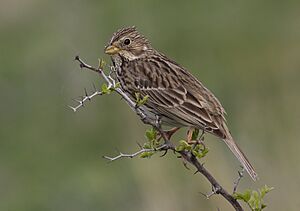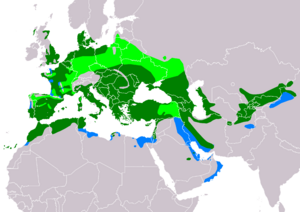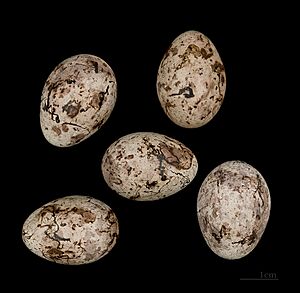Corn bunting facts for kids
Quick facts for kids Corn bunting |
|
|---|---|
 |
|
| In Adana, Turkey | |
| Conservation status | |
| Scientific classification | |
 |
|
| Range of E. calandra Breeding Resident Non-breeding | |
| Synonyms | |
|
The corn bunting (Emberiza calandra) is a type of bird that belongs to the bunting family. It's a fairly large bird with streaky brown feathers. Both male and female corn buntings look quite similar, but the male is a bit bigger. You can find these birds living across Western Europe, North Africa, and all the way to northwestern China.
Contents
About the Corn Bunting
How Scientists Name Them
The corn bunting was first officially described by a Swedish scientist named Carl Linnaeus in 1758. He gave it the scientific name Emberiza calandra. This name is still used today! The word Emberiza comes from an old German word for a bunting. The word calandra comes from an ancient Greek word for a type of lark.
What Does It Look Like?
The corn bunting is a large, sturdy bird, usually about 16 to 19 centimeters long. It has a noticeably dark eye and yellowish beak. Unlike some other buntings, the male corn bunting doesn't have bright, showy colors on its head.
Both male and female corn buntings look quite similar. They have streaky grey-brown feathers on their backs and whitish feathers underneath. Their chests and sides also have streaks. Their tails are plain brown.
What Does It Sound Like?
The male corn bunting has a unique song. It's a repetitive, metallic sound that many people say sounds like jangling keys. You'll often hear them singing from a low bush, a fence post, or even telephone wires.
Where Do Corn Buntings Live?
Habitat and Range
Corn buntings live across southern and central Europe, north Africa, and Asia, reaching as far as Kazakhstan. Most corn buntings stay in the same area all year. However, some birds from colder parts of central Europe and Asia will migrate south for the winter.
These birds prefer open areas with some trees. You can often find them in farmlands or weedy, undeveloped land.
Why Are They Declining?
Sadly, the number of corn buntings has dropped a lot in northwest Europe. This is mainly because of modern farming methods. These methods reduce the amount of weed seeds and insects available, which are important food sources for the birds. Insects are especially vital for feeding young chicks. The corn bunting has even disappeared from Wales and Ireland, where it used to be very common.
Corn Bunting Behavior
What Do They Eat?
Corn buntings mainly eat seeds. But they also eat insects, like crickets, especially when they are feeding their young.
How Do They Raise Their Young?
During the breeding season, male corn buntings defend their own areas. A male might mate with more than one female, sometimes up to three. However, there are usually an equal number of males and females in the population. This means some males might not find a mate.
Males don't do much of the parenting. They don't help build the nest or sit on the eggs. They only start feeding the chicks once the chicks are more than half grown.
The nest is usually built on the ground. It's made of grass and lined with softer materials like hair or fine grass. A female corn bunting typically lays four eggs, but sometimes it can be three to five, or even six.
Protecting Corn Buntings
In England, the government's environmental group, Natural England, offers help to farmers. They provide money to encourage farmers to use methods that help protect species like the corn bunting. This is part of a program called the environmental stewardship scheme.




